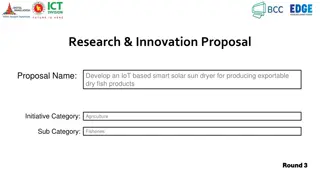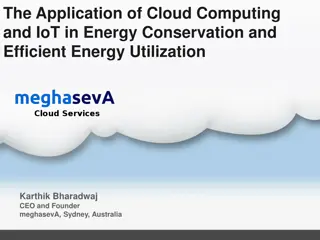National Standards for IoT in Smart Cities - Perspectives and Interworking
Explore the significance of national standards for IoT in smart cities through oneM2M use cases, interworking, testing, certifications, and 3GPP enhancements for MTC. Learn about simplifying service layers, device abstraction, and interworking in cellular IoT technologies. The session delves into the complexities faced by smart city stakeholders due to varied technology choices and how oneM2M's globally specified APIs streamline operations, fostering interoperability.
Download Presentation

Please find below an Image/Link to download the presentation.
The content on the website is provided AS IS for your information and personal use only. It may not be sold, licensed, or shared on other websites without obtaining consent from the author.If you encounter any issues during the download, it is possible that the publisher has removed the file from their server.
You are allowed to download the files provided on this website for personal or commercial use, subject to the condition that they are used lawfully. All files are the property of their respective owners.
The content on the website is provided AS IS for your information and personal use only. It may not be sold, licensed, or shared on other websites without obtaining consent from the author.
E N D
Presentation Transcript
C-DOT-TSDSI Webinar Series: The National Standards for IoT Smart Cities Perspective IoT Standards and Smart Cities: oneM2M use cases, interworking, Testing and Certifications 3GPP Interworking in oneM2M By Bob Flynn Vice-chair Test and Development Ecosystem (TDE) oneM2M
3 Standards for Cellular Internet of Things oneM2M 3GPP GSMA
4 oneM2M Provides a Simpler Abstracted View Service Layer OMA DM ZigBee (dotdot) OMA DM ZigBee (dotdot) LWM2M OPC-UA BBF OCF LWM2M OPC-UA BBF OCF XML JSON CBOR XML JSON CBOR MQTT(s) CoAP(s) HTTP(s) MQTT(s) CoAP(s) HTTP(s) TLS/PSK DTLS/PSK TLS/PKI TLS/PSK DTLS/PSK TLS/PKI Cellular Fixed Wi-Fi Bluetooth NB-IoT LoRA Sigfox Cellular Fixed Wi-Fi Bluetooth NB-IoT LoRA Sigfox Today Smart City Stakeholders are exposed to many different technology choices. This leads to complexity and hampers interoperability. Using oneM2M, the developer only uses the globally specified oneM2M APIs. This greatly simplifies life for Smart City Stakeholders
5 Standards for Cellular Internet of Things IoT Device Abstraction and Interworking Device Management oneM2M 3GPP GSMA
3GPP Enhancements for MTC 3GPP Enhancements for MTC E-UTRAN network resource optimizations based on communication patterns provided to the MME Support of setting up an AS session with required QoS Change the chargeable party at session set-up or during the session Extended idle mode DRX Non-IP Data Delivery (NIDD) -------Release 15 23.682 ------------------ Support of PFD management via SCEF MSISDN-less MO-SMS via T4 Enhanced Coverage Restriction Control via SCEF MBMS user service for UEs using power saving functions Enhancements to Location Services for CIoT MBMS user service for NB or M UE categories Network Parameter Configuration via SCEF SCEF - SCS/AS API Procedures Charging Principles -------Release 13 23.682 ------------------ Device Triggering Function PS-only Service Provision Core Network assisted RAN parameters tuning UE Power Saving Mode Group Message Delivery Monitoring Events Monitoring the association of the UE and UICC and/or new IMSI-IMEI-SV association; UE reachability; Location of the UE, and change in location of the UE; Loss of connectivity; Communication failure; Roaming status (i.e. Roaming or No Roaming) of the UE, and change in roaming status of the UE; and Number of UEs present in a geographical area; Availability after DDN failure. Offline Charging High latency communication Support of informing about potential network issues Resource management of background data transfer
7 Standards for Cellular Internet of Things IoT Device Abstraction and Interworking Device Management 3GPP Interworking oneM2M 3GPP GSMA Device Triggering Function Core Network assisted RAN parameters tuning UE Power Saving Mode Group Message Delivery Monitoring Events UE reachability; Location of the UE, and change in location of the UE; Loss of connectivity; Communication failure; Roaming status (i.e. Roaming or No Roaming) of the UE, and change in roaming status of the UE; and High latency communication Resource management of background data transfer Non-IP Data Delivery (NIDD)
8 Massive IoT Device Deployment IoT Service Provider Cellular IoT Devices (NB-IoT, LTE-M) 3GPP Core Network IoT Server Application IoT Features IoT Service Platform control Design data Deployment Error scenario 8
GSMA TS 34 IoT Device Connection Efficiency Guidelines IoT Service IoT Service Platform IoT Service Provider The provider of IoT services working in partnership with a network operator to provide an IoT service to an end customer. The provider could also be an MNO. IoT Service Provider Requirements: TS.34_6 3GPP Mobile Network 3GPP Connection Efficiency Features: TS.34_9 Mobile Network Operator The mobile network operator(s) connecting the IoT device application to the IoT service platform. IoT Device IoT Device The combination of both the IoT device application and the communication module. IoT Device Requirements: TS.34_3 IoT Device Application The application software component of the IoT device that controls the communications module and interacts with an IoT service platform via the communications module. IoT Device Application Requirements: TS.34_4 IoT Device Application Communication Module The communications component which provides wide area radio connectivity Communications Module Firmware The functionality within the communications module that provides an API to the IoT device application and controls the radio baseband chipset. Communication Module Communication Module Requirements: TS.34_5 Connection Efficiency Requirements: TS.34.7 Communication Module Firmware Radio Baseband Chipset The functionality within the communications module that provides connectivity to the mobile network. UICC The smart card used by a mobile network to authenticate devices for connection to the mobile network and access to network services. Radio Baseband Chipset UICC (SIM) Radio Policy Manager Requirements: TS.34_8
10 Standards for Cellular Internet of Things IoT Device Abstraction and Interworking Device Management 3GPP Interworking CMDH oneM2M 3GPP GSMA Device Triggering Function Core Network assisted RAN parameters tuning UE Power Saving Mode Group Message Delivery Monitoring Events UE reachability; Location of the UE, and change in location of the UE; Loss of connectivity; Communication failure; Roaming status (i.e. Roaming or No Roaming) of the UE, and change in roaming status of the UE; and High latency communication Resource management of background data transfer Non-IP Data Delivery (NIDD) IoT Application Requirements IoT Device Requirements Mobile Network Operator Requirements IoT Service Provider Requirements
11 Standards for Cellular Internet of Things IoT Device Abstraction and Interworking Device Management 3GPP Interworking CMDH oneM2M 3GPP GSMA Device Triggering Function Core Network assisted RAN parameters tuning UE Power Saving Mode Group Message Delivery Monitoring Events UE reachability; Location of the UE, and change in location of the UE; Loss of connectivity; Communication failure; Roaming status High latency communication Resource management of background data transfer Non-IP Data Delivery (NIDD) IoT Application Requirements IoT Device Requirements Mobile Network Operator Requirements IoT Service Provider Requirements Protect the Network
12 GSMA recommends a better way IoT Device Host IoT Service Provider Architecture Evolved GSMA 3GPP Mobile Network IoT Device Application IoT Server Application IoT Embedded Service Layer IoT Service Platform Infrastructure Node (IN) Application Service Node (ASN) ASN-AE Architecture oneM2M IN-AE 3GPP Mobile Network Mca Mca IN-CSE ASN-CSE
13 MNO Deployment CSE notifies devices 4. Device Starts communicating according to different policies 3. Core Network identifies data congestion SCEF notifies CSE Mgmt Objects CMDH Policies 1. oneM2M 3GPP device registers to MNO Service Mgmt Objects CMDH Policies 2. Device Starts communicating according to the policies Sensor Data Normal Priority Sensor Data Device Management Data Mgmt Data High Priority
14 Summary Large scale deployments of IoT devices have the risk of negatively impacting the mobile network GSMA created a list of recommendations to help ensure No Harm To the Network oneM2M can implement the TS34 requirements in an ASN-CSE GCF Authorized Test Labs can verify and certify devices Fast time to market with safe and reliable solutions using open standards based on oneM2M!
About Me Bob Flynn Vice chair, oneM2M Test and Development Ecosystem Founder and Principal Technology Consultant www.exactagss.com https://www.linkedin.com/in/bobflynniv 16
https://www.exactagss.com/assets/september2019--do-no-harm.pdfhttps://www.exactagss.com/assets/september2019--do-no-harm.pdf https://www.chordant.io/white_papers/no-harm-to-networks- https://www.gsma.com/iot/resources/no-harm-to-networks/ References oneM2M Website: http://onem2m.org/ 17























